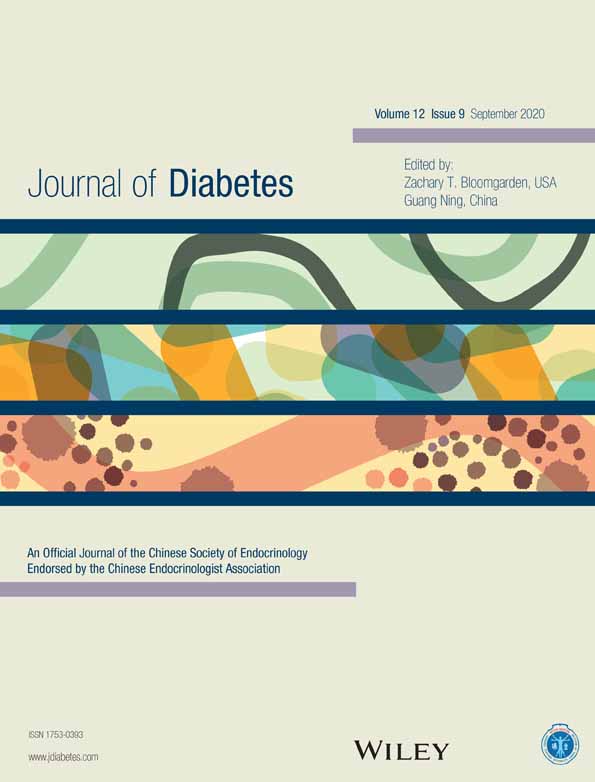Joint impact of muscle mass and waist circumference on type 2 diabetes in Japanese middle-aged adults: The Circulatory Risk in Communities Study (CIRCS)
肌肉量和腰围对日本中年人2型糖尿病的联合影响:循环系统风险的社区研究(CIRCS)
Funding information: JSPS KAKENHI, Grant/Award Number: 18K19665; Research Grant from National Center for Geriatrics and Gerontology, Grant/Award Number: 29-42; the Japan Small- and Medium-Sized Enterprise Welfare Foundation (FULLHAP); the JSPS (Japan Society for the Promotion of Science)
Abstract
enBackground
Although evidence about skeletal muscle mass loss and type 2 diabetes risk has accumulated, little information is available on the combined effect of skeletal muscle mass and abdominal obesity on type 2 diabetes. We examined whether skeletal muscle mass and abdominal obesity were synergistically associated with the prevalence of type 2 diabetes.
Methods
Skeletal muscle mass and waist circumference (WC) were measured in 1515 Japanese aged 40 to 69 years. Relative muscle mass was calculated as percentage of total skeletal muscle mass in body weight (SMM%). Type 2 diabetes was identified as fasting serum glucose ≥7.0 mmol/L (126 mg/dL), nonfasting serum glucose ≥11.1 mmol/L (200 mg/dL), glycosylated hemoglobin ≥ 6.5%, and/or diabetes medication use.
Results
The multivariable-adjusted odds ratio (OR) of prevalent diabetes from the lowest to the third quartile of SMM% compared to the highest quartile gradually increased in both sexes. The association between a high WC and prevalent diabetes was similar. The multivariable-adjusted OR (95% confidence intervals) for the prevalence of type 2 diabetes in the low skeletal muscle mass/high WC group was 3.19 (1.78-5.71) for men and 4.46 (2.09-9.51) for women compared with the high skeletal muscle mass/low WC group. The relative excess risk due to interaction was 2.2 (0.5-3.9) in men and 2.8 (0.2-5.3) in women for an excess burden of type 2 diabetes for low skeletal muscle mass and high WC.
Conclusions
Low skeletal muscle mass and abdominal obesity were synergistically associated with presence of type 2 diabetes.
摘要
zh背景
虽然关于骨骼肌肉质量的下降与2型糖尿病风险的证据已有研究, 但关于骨骼肌质量和腹型肥胖对2型糖尿病的联合作用的信息很少。我们研究了骨骼肌质量和腹型肥胖是否与2型糖尿病的患病率协同相关。
方法
测量1515名40-69岁日本人的骨骼肌质量和腰围。相对肌量以总骨骼肌质量占体重的百分比(SMM%)计算。2型糖尿病被定义为空腹血糖≥7.0 mmol/L(126 mg/dL), 非空腹血糖≥11.1mmol/L(200mg/dL), 糖化血红蛋白≥6 5%, 且或正在使用糖尿病药物。
结果
相对肌量最低的四分之一与最高四分之一相比, 男性及女性糖尿病患病率的多变量调整优势比(OR)都有所升高。较高腰围和糖尿病发病率之间的联系也是相似的。与高骨骼肌质量/低腰围组相比, 低骨骼肌质量/高腰围组的2型糖尿病患病率多变量调整OR值于男性为3.19(1.78~5.71), 女性为4.46(2.09~9.51)。低骨骼肌质量与高腰围之间的交互作用导致了额外的糖尿病相对风险, 男性为2.2(0.5-3.9), 女性为2.8(0.2-5.3)。
结论
低骨骼肌质量和腹型肥胖与2型糖尿病发病存在协同关系。




